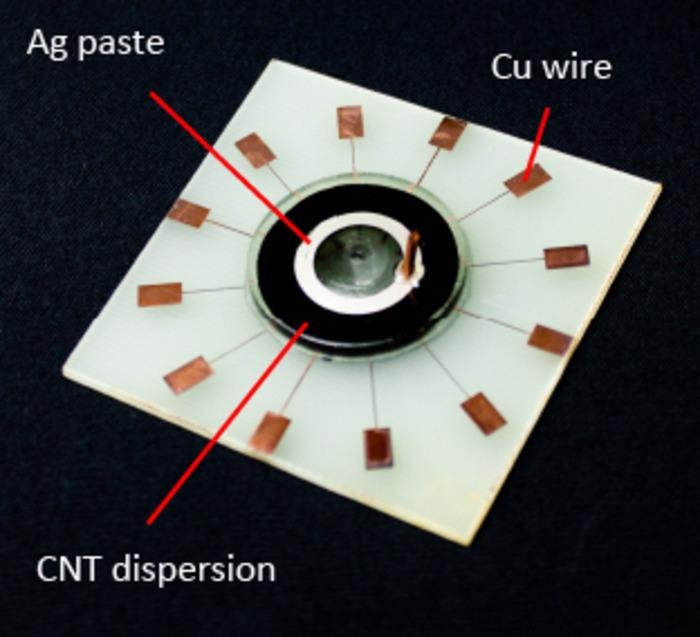During a storm or other turbulence, the orientation of the plane and the angle at which the plane is tilted toward Earth’s surface are vital information a pilot needs to know. If the nose of the plane is tilted downward at a 45° angle, for example, the direction and angle should be balanced to ensure altitude.
 The liquid-state digital tilt sensor. The sensor uses a conductive liquid to read the tilt angle and direction as digital binary signals. Image Credit: Yokohama National University.
The liquid-state digital tilt sensor. The sensor uses a conductive liquid to read the tilt angle and direction as digital binary signals. Image Credit: Yokohama National University.
However, the sensor in control of measuring this critical information requires intricate outer circuits and its inner mechanisms can drift with use, resulting in a build-up of errors.
To enhance the tilt sensor, Hiroki Ota, associate professor, and his graduate student, Ryosuke Matsuda, in the Department of Mechanical Engineering at Yokohama National University in Japan have created a small, basic version that can be scaled for different applications. Their approach has been reported in the July 21st issue of Advanced Materials Technologies.
For further application of tilt sensors, a simple measurement system is essential. In this study, we developed a sensor that can detect tilt by simply turning a direct current on and off using a conductive liquid material.
Hiroki Ota, Associate Professor, Department of Mechanical Engineering, Yokohama National University
Currently, the available tilt sensors comprise sub-sensors to calculate acceleration and angular rate against the vibrations of the host object, like an aircraft or a person supplied with a wearable device. The measurements have to be processed via the external circuitry before they can be comprehended as the tilt calculation.
A few present-day systems use liquid electrolytes to calculate the tilt state electrically, where the liquid stimulates an alternating current that signals the direction and tilt angle. Nevertheless, according to Ota, alternating current is complicated and necessitates external circuitry for processing.
Conventional tilt sensors using an electrolyte require alternating current, making it difficult to reduce the size of the system. The sensor fabricated in this study has a digital output using direct current, which enables direct electrical measurement of tilt.
Hiroki Ota, Associate Professor, Department of Mechanical Engineering, Yokohama National University
Electrolytes do not transmit current, so the scientists chose a liquid made up of carbon nanotubes dispersed in water.
“By using a highly fluid conductive liquid, the sensor can measure not only the tilt direction but also the angle in one direction,” Ota stated.
The liquid provides conductivity in keeping with the inclination direction, which is acquired from direct current electrodes’ electrical on-off signal. The liquid travels freely along the inclination, while a space that adds up to an air pocket moves in the opposite direction.
In the tilted state, the air pocket moves to switch the conduction and insulation of the electrodes. This feature offers the advantage that the inclination direction can be detected without any external calculation mechanisms.
Hiroki Ota, Associate Professor, Department of Mechanical Engineering, Yokohama National University
The team tested the sensor successfully on a three-pronged device which, when tilted, heated a balloon under the downward prong. The balloon would enlarge and lift the prong to make the device horizontal, blocking off the power to the heater. They also employed the sensor as a motion-tracking device, fixing it to the head of a researcher who tilted his head in different directions, all of which were perfectly mapped.
The device fabricated in this study can measure the tilt angle using a functional liquid. In the future, we aim to extend this function to create a multi-physical sensor that can simultaneously measure other physical quantities such as pressure and strain deformation.
Hiroki Ota, Associate Professor, Department of Mechanical Engineering, Yokohama National University
Ota states that the scientists plan to promote their sensors as a less bulky option for wearable devices and robots with a narrow installation room.
Ota is also affiliated with the Graduate School of System Integration at Yokohama National University. The study was co-authored by Umihiro Kamoto and Song Ziharo, all with the Department of Mechanical Engineering at Yokohama National University.
This study was supported by PRESTO (grant no. JPMJPR18J2) and CREST (JPMJCR1905) from the Japanese Science and Technology Agency. H.O. acknowledges financial support from a Grant-in-Aid for Scientific Research (A) offered by the Japanese Society for the Promotion of Science.
Journal Reference:
Matsuda, R., et al. (2021) Liquid-Based Digital Readable Tilt Sensor. Advanced Materials Technologies. doi.org/10.1002/admt.202100490.